Béchamel based Creamy Shrimp Croquettes are as popular as Korokke (Japanese Potato and Ground Meat Croquettes) in Japan. They might look a bit fiddly but actually it doesn’t take long to make them. Unlike potato-based croquettes, you can enjoy the rich creamy flavour without pouring a sauce over the top.
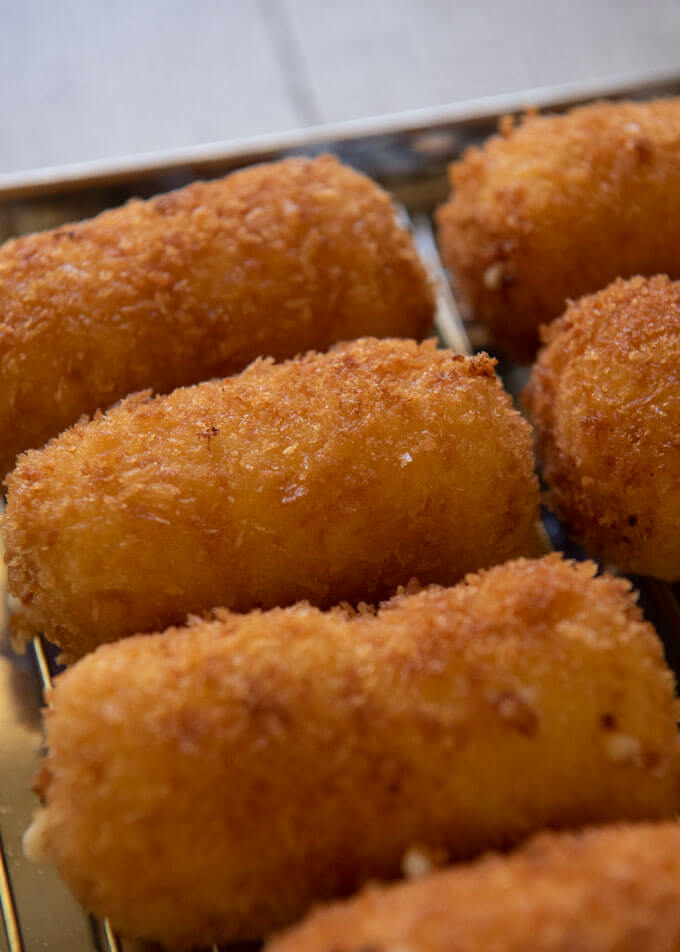
Japanese people do like croquettes and so do I. There are so many different kinds of Japanese croquettes sold at food stores in Japan and they are basically divided into two groups – potato-based croquettes and béchamel-based croquettes.
The potato croquettes are generically called ‘poteto korokke’ (ポテトコロッケ) and the béchamel-based creamy croquettes are called ‘kurīmu korokke” (クリームコロッケ). By adding different ingredients to the base, each kind of croquette is given a unique name.
For example, mixed vegetables in potato-based croquettes are called ‘yasai korokke’ (野菜コロッケ) . If vegetables are in béchamel sauce, it becomes ‘yasai kurīmu korokke’ (野菜クリームコロッケ). The word ‘yasai’ (野菜) means vegetables.
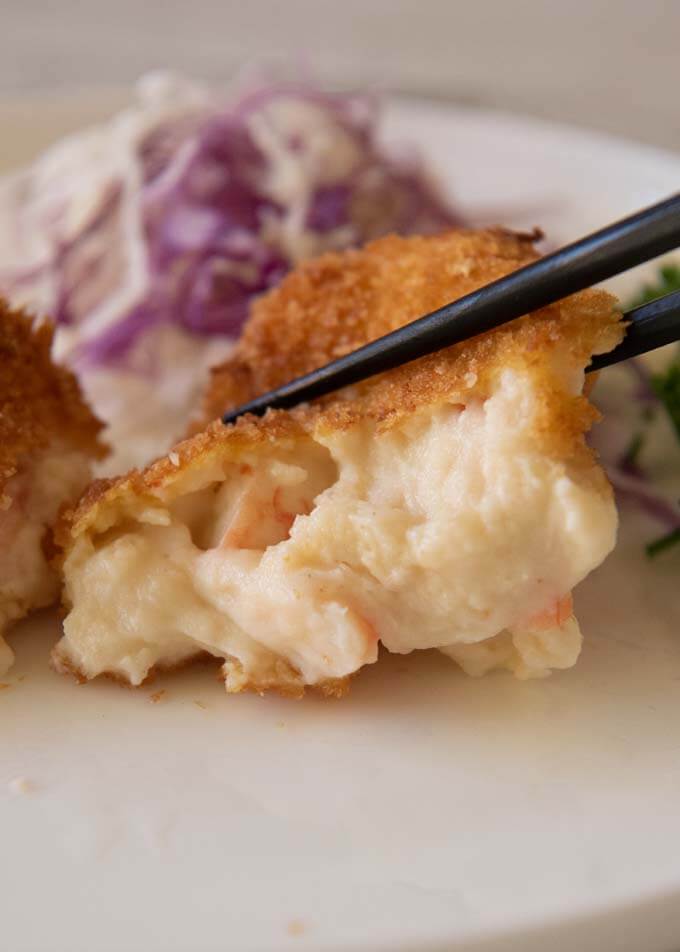
Depending on the ingredients that go with béchamel sauce, the method of making the croquette base varies slightly. But fundamentally, it’s a mixture of béchamel sauce and the key ingredients with flavouring.
Flavouring of My Creamy Shrimp Croquettes
Some recipes add chicken stock powder to give a good flavour to the béchamel sauce. Some recipes sauté prawns and onions first with a small amount of wine, then mix into to the béchamel sauce.
I tried both methods, but I wasn’t happy with the prawn flavours in the sauce. So, I decided to cook fresh prawns (with shells on) in milk to extract a good prawn flavour, then use the milk to make béchamel sauce (see the first photo of step-by-step photo in the next section). The cooked prawns are peeled, chopped and mixed into the béchamel sauce.
This is faster than sautéing the prawns separately, is less oily and gives a good prawn flavour to the sauce. When cooking the prawns in milk, I also add a small amount of onions, a bay leaf, nutmeg, salt and pepper.
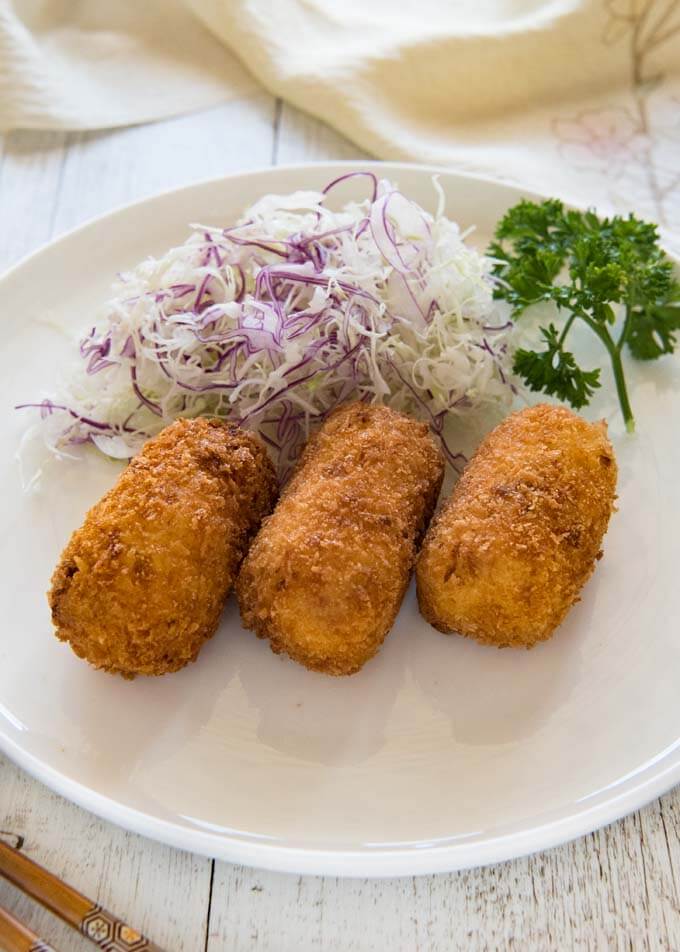
Key Points to Shape Béchamel Sauce into Croquettes.
Compared to the béchamel sauce used to make Macaroni Gratin, the sauce for the creamy croquettes is much thicker. The amount of milk used in this recipe is less for the amount of roux made with butter and flour.
But while it is still warm, the sauce is too soft to shape. There are a couple of things you can do to make your life easier.
- Chill the mixture in the fridge or freezer. When chilled, the butter in the sauce hardens and the mixture becomes like a dough. Spread the béchamel mixture in a tray into a square or a rectangle shape (so that you can divide it into equal portions easily). Cover the surface with cling wrap to prevent it from drying and chill it.
- Oil your hands to shape the mixture into a fat log shape (see the photo below). Without it, you will find that the mixture sticks to your hands.
- As soon as you make fat logs, coat them in flour, egg and panko breadcrumbs. The longer you leave them, the softer the mixture gets (unless your room is super cold!) and this will make it more difficult to keep the shape.
The inside of the croquette is already cooked so you don’t need to deep fry for a long time. You only fry croquettes for about a couple of minutes at 175-180C/350F until the breadcrumbs become golden brown.
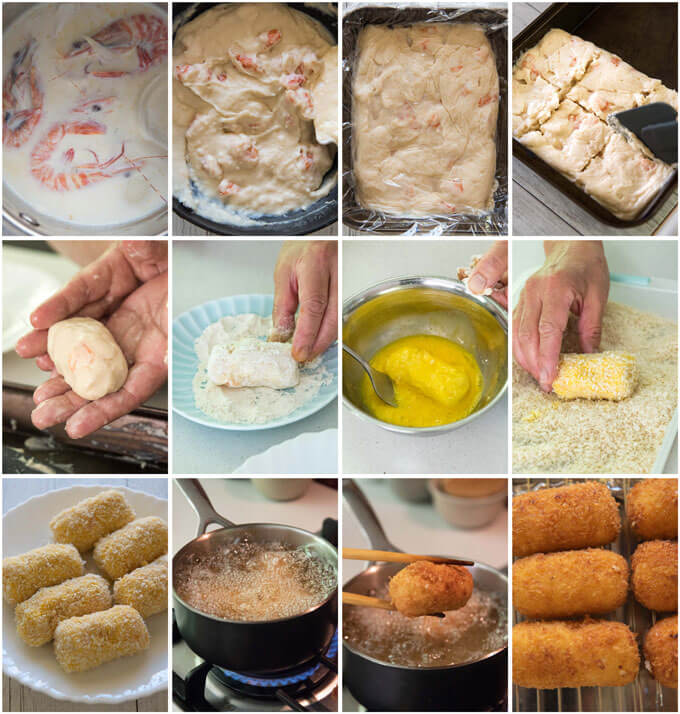
Perfect Frozen Food
The beauty of this dish is that you can make croquettes ahead of time, freeze them and re-heat them later. You can freeze them either before deep frying or after deep frying. Frozen croquettes keep about a month.
Freeze Before Frying
Storage: Wrap each crumbed croquette in cling wrap and place them on a flat tray without overlapping. Once frozen, you can pile them up in a bag or a container to store.
Cooking: Defrost in a microwave for 1 minute (per croquette), then deep fry at 175-180C/350F until golden brown. Do not overcrowd the oil with too many croquettes.
Freeze After Frying
Storage: Wrap each croquette in cling wrap and place them on a flat tray without overlapping. Alternatively, place croquettes without touching each other in a container with a lid and freeze. Once frozen, you can pile them up in a bag or a container to store.
Reheating: Microwave for a minute to defrost (per croquette), then place them on a tray with a rack or lined with scrunched aluminium foil. Bake at 200C/392F for 15 minutes.
Creamy inside and crunchy outside, this is a great way to enjoy the Japanese version of a Western style dish. Best to eat while hot – see how soft the inside of the croquette is!
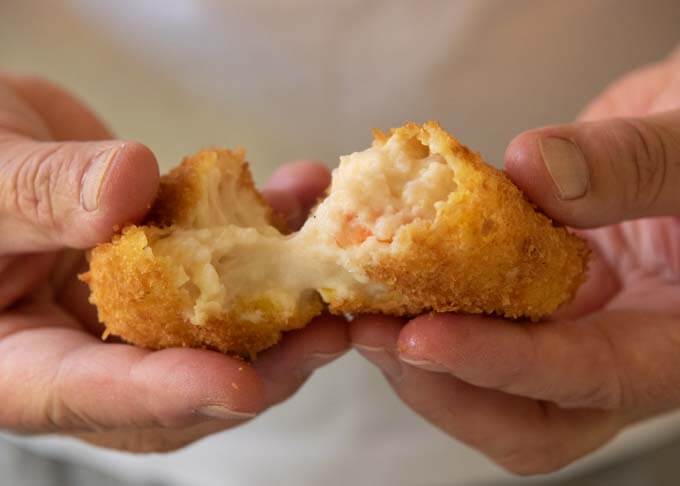
From the nutrition perspective, Creamy Shrimp Croquettes are slightly higher calories than Korokke (Japanese Potato and Ground Meat Croquettes), possibly because of the amount of butter and milk included in the béchamel sauce. But when you eat them you don’t find them heavy at all. They are actually quite light yet sufficiently rich.
Yumiko
![]()
P.S. Don’t forget to see the section ‘MEAL IDEAS’ below the recipe card! It gives you a list of dishes that I have already posted and the new recipe in this post that can make up a complete meal. I hope it is of help to you.

Béchamel based Creamy Shrimp Croquettes are as popular as Korokke (Japanese Potato and Ground Meat Croquettes) in Japan. They might look a bit fiddly but actually it does not take long to make them. Great to make ahead and freeze.
Unlike potato-based croquettes, you can enjoy the rich creamy flavour without pouring a sauce over the top.
Total Time does not include the time to chill the béchamel mixture.
- 150g/5.3oz fresh uncooked medium size prawns/shrimps in shell (note 1)
- 50g/1.8oz onion roughly chopped
- 300ml/10.1oz milk
- A couple of shakes of nutmeg powder
- 1 bay leaf
- ¼ tsp of salt
- Pepper
- 30g/1.1oz butter
- 40g/1.4oz flour
- 2 tbsp flour
- 1 egg , beaten
- 1 cup panko breadcrumbs
- Neutral oil (vegetable, canola) for deep frying
- Shredded cabbage
- 2 sprigs parsley
-
Add the Creamy Shrimp Mixture ingredients, except butter and flour, to a saucepan and heat over medium high heat.
-
When the outside of the milk starts bubbling, shake the pan occasionally so that the milk does not burn along the side of the pan.
-
When the milk starts simmering gently, turn the heat down to low and simmer for a minute or until the prawns become red and curled up.
-
Remove from the heat and leave for another minute. Put the milk through a sieve and reserve for béchamel sauce.
-
Let the prawns cool down a bit, then remove heads and peel the shells. Chop each prawn into 3-4 small pieces.
-
Melt butter in a frying pan over low heat.
-
Add flour and mix well. Cook for 3 minutes, stirring constantly ensuring the roux does not change colour.
-
Add 1/3 of the reserved milk and mix well to incorporate until lump free (note 2).
-
Add the remaining milk to the roux in two batches and mix well in the same way.
-
Add prawn pieces and mix to spread prawns evenly.
-
Transfer the mixture to a tray and shape it into a square or a rectangle of about 2.5cm/1” thickness.
-
Cover the surface of the mixture with cling wrap to prevent it from drying up. Let it cool down, then chill in the fridge for a couple of hours (note 3).
-
Divide the shrimp mixture into 6 equal portions.
-
Oil your hands and shape each portion into a fat log shape.
-
Place flour, egg and breadcrumbs individually in shallow plates or bowls.
-
Coat each piece with flour, egg, then breadcrumbs. Ensure that the surface of the croquette is well covered with the coatings otherwise the soft cream will ooze out from the gap while frying.
-
Heat oil in a deep fry pan to 175-180C/350F. Gently drop a few pieces in (note 4) and fry for a couple of minutes until the breadcrumbs become golden brown.
-
Transfer the croquette to a plate lined with kitchen paper to absorb the excess oil, or a tray with a rack.
-
Serve immediately with shredded cabbage and a stem of parsley leaves.
1. If you only have peeled prawns, you will need 80g. The prawn flavour in the milk will not be as intense.
2. If required, use a whisk to remove lumps.
3. You could chill it in the freezer too. As long as the béchamel mixture becomes cold and firm it will be OK to shape croquettes.
4. I used a small sauce pan to deep fry three croquettes at a time. After dropping one croquette in the oil, I placed another croquette on top of the one in the oil so that the croquette gently rolled into the oil.
5. You can freeze Creamy Shrimp Croquettes either before deep frying or after deep frying. Frozen croquettes keep about a month.
FREEZE BEFORE FRYING: Wrap each crumbed croquette in cling wrap and place them on a flat tray without overlapping. Once frozen, you can pile them up in a bag or a container to store.
To cook, defrost in a microwave for 1 minute (per croquette), then deep fry at 175-180C/350F until golden brown. Do not overcrowd the oil with too many croquettes.
FREEZE AFTER FRYING: Wrap each croquette in cling wrap and place them on a flat tray without overlapping. Alternatively, place croquettes without touching each other in a container with a lid and freeze. Once frozen, you can pile them up in a bag or a container to store.
To reheat, microwave for a minute (per croquette) to defrost, then place them on a tray lined with scrunched aluminium foil. Bake at 175-180C/350F for 15 minutes.
6. Nutrition per croquette, assuming that the amount of oil absorbed into a croquette is 10% of the weight of the croquette.
serving: 139g calories: 378kcal fat: 18g (28%) saturated fat: 3.3g (16%) trans fat: 0.1g polyunsaturated fat: 4.4g monounsaturated fat: 9.3g cholesterol: 40mg (13%) sodium: 284mg (12%) potassium: 203mg (6%) carbohydrates: 44g (15%) dietary fibre: 2.1g (8%) sugar: 1.9g protein: 9.6g vitamin a: 4.2% vitamin c: 1.9% calcium: 8.8 % iron: 15 %
Meal Ideas
A typical Japanese meal consists of a main dish, a couple of side dishes, a soup and rice. I try to come up with a combination of dishes with a variety of flavours, colours, textures and make-ahead dishes.
Although high in fat, Creamy Shrimp Croquettes do not contain a lot of protein, so I included Chicken Patties as a side (1-2 pieces per serving). Both the main and side dish 1 can be made ahead if time is limited on the day of serving. The soup does not have to be miso based but in either type of soup, try to pick light ingredients.
Daikon is a great company to the fried dish as it helps digestion. Sour plum dressing also goes well with the deep fried dish. But if you prefer, you can use other dressings.
- Main: Creamy Shrimp Croquettes – today’s recipe, can be made ahead
- Side dish 1: Chicken Patties Wrapped in Perilla – serve as a side, can be made ahead
- Side dish 2: Daikon Salad with Pickled Plum Dressing – instead of plum dressing, you could use Wasabi Dressing
- Soup: Tofu and Wakame Miso Soup – or any other soup of your choice
- Rice: Cooked Rice
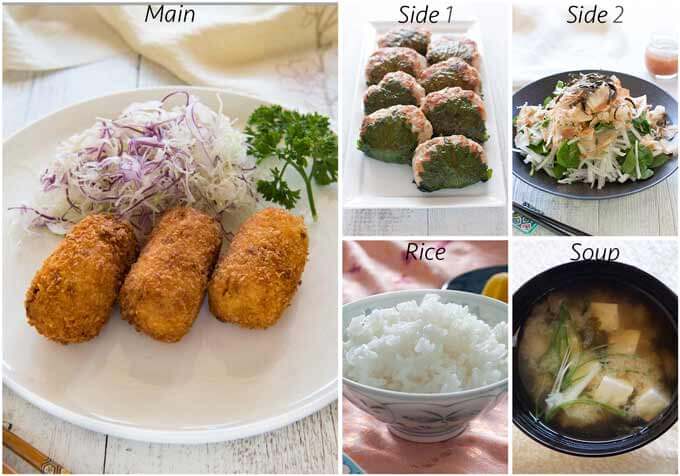
Hi Yumiko,
Can we substitute the milk with sour cream instead? I can’t wait to try them, thank you…
Hi Ayu, unfortunately, sour cream won’t work. Your croquettes will taste sour which is not nice for a cream croquette.
Hello,
I am in the process of preparing a big number of croquettes but it started bad with the milk curdling like cheese! I think both the onion and most likely the salt should be added at the very end because of their acidity (which causes milk to curdle). I will nevertheless use the liquid to make the béchamel and hopefully I will manage…..
Hi Mike, putting milk through a sieve removes not only the ingredients but curdled bits. Good luck with making croquettes!
When I was a child, my mother would make croquettes from bacalao, other fish, ham or chicken for dinner. They were among my favorite meals ever. Over the years I have tried and failed to make similar croquettes. They always fell apart when frying. I have searched the web for a recipe that would do it for me. Not much success. Then I found yours. Yours is the most detailed and comprehensive recipe I have found. It shows you know what you are doing and know how to present the information. I see that your ratio of flour to milk is on the order of 1:7.21. Other recipes I have tried used ratios of 1:10 or 1:9. I suppose that is why they fell apart. I also suppose the writers of those recipes never made what they presented. I know you have. I will give yours a try and report back. Thank you for your wonderful efforts. BTW do you have any comments re: the flour to milk ratio?
Hi Americo, I checked on the flour to milk ratio on other Japanese recipes. Most of them tend to be similar to my ratio or even a bit more flour. Having said that, I think the key is the right thickness of the béchamel sauce. Perhaps the recipes you referred to in the past needed to cook the sauce longer to make it thicker. As you can see in the step-by-step photo in my post, the sauce is thicker than the standard béchamel sauce. When you scoop the sauce with a spatula, it should drop like a soft lump, rather than dribble.
Good luck with it and pleas let me know how it went.
Hi… I tried making it this weekend. It’s good but my mixture was still very wet . I did manage to make it happen (into croquette balls) but boy it seems like I am battering my hands instead of the mixture. So needless to say a lot of the sauce/creaminess got wasted. What did I do wrong? I did use macadamia milk, could this be? Maybe I needed more roux? I thought of freezing the mixture solid but then it might get watery. Any pointers would be appreciated as I would like to try making it again.. Also, your recipe note # 2 and #3 is the same. Thank you.
Hi Cathleen, I don’t think the milk was the problem. When the prawns were cooked and drained, perhaps the amount of milk leftover and to be added to the roux was a bit more that what I got. When adding the last batch of milk, try half of it and see check the thickness of the white sauce and then adjust.
The most delicious shrimp croquettes I ever made. To shape them well, I double coated them .
Thankyou for sharing the recipe!
Hi Radha, thanks a lot. You are so clever to double coat them!
I cooked this and the recommended side dishes tonight. They were delicious. But I would like to know how you get nicely shaped croquettes. I couldn’t do it!
Hi David, I am sorry that the shape of the croquettes was a challenge but the flavour matters most!
To make a nice log shape, I place one portion of cooled mixture on my left palm (I’m a right hander) which is shaped like a bowl. Then with right hand over the mixture gently roll to make a log in the left hand. After that, squeeze the both ends of the log using the thumb and the index finger of your right hand while squeezing the left fingers to keep the round log shape. This is only possible while the mixture is cold and reasonably hard. If the mixture got softened, put it back to the fridge/freezer to harden a bit.
I have not tried this yet but the alternate method could be to wrap the mixture in a long log, twist the both ends to seal, then chill. The hardened log can be cut to the appropriate length, then fix the both ends to shape. I read this method in one of the Japanese recipes.
Good luck with the shape next time.
Hi Yumiko,
It’s so interesting reading your detailed explanation of croquettes. Excellent idea to prepare in advance for parties.
Cheers,
Lorri
Thank you, Lorri!
I follow all your recipes and read with interest. Wonderful refreshing ideas, inspirational, thank you.
Hi Denise, thank you very much!
Hello:
Is there any nondairy substitute for the milk?
Hi Jaya, I have not used non-dairy milk for béchamel sauce but I cannot see why you cannot use soy milk, rice milk, coconut milk etc. The taste can be a bit different as soy, for example, has its unique flavour. Quantity of milk should be the same.
Yumiko, your recipes are so detailed and all the notes are really helpful, I’m so grateful for all the effort you put into writing them. I lived in Japan for a few years and grew to love Japanese food, so it’s fantastic to have your website as a resource on how to cook authentic Japanese dishes. Many, many thanks to you!
I have a question about the shredded cabbage that often accompanies Japanese dishes, which I love; how do you shred it so finely? I have tried chopping it as closely as possible, but it always ends up quite chunky. Do you use a particular utensil? Again, many thanks.
Hi Annie, thank you very much for your kind words! Regarding shredding cabbage, my kitchen knife skill is not that great to be able to shred cabbage like that (hahaha). I use a super wide peeler. I found it at Sydney Market several years ago. You know one of those stands which appear from time to time to sell little gadget like that?
You might find super wide peeler at kitchen specialty shops but you can also buy it on line, eg. here. If you goole search ‘super wide peeler’, you will find other brands, too.
You need to have a block of cabbage with the core intact to make shredded cabbage. Simply slide the peeler on the cut side of the cabbage. Warning!: shredded cabbage could scatter everywhere. Then I wash the shredded cabbage which becomes crispy.
Thanks for answering so promptly and for the great information Yumiko, I will try and hunt one down. Best regards, Annie